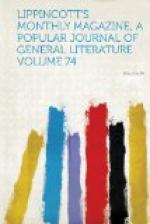A certain air of quaint interest and life is given to the otherwise desolate streets by the groups of Kafirs and the teams of wagons which bring fuel and forage into the town every day. Twenty bullocks drag these ponderous contrivances—bullocks so lean that one wonders how they have strength to carry their wide-spreading horns aloft; bullocks of a stupidity and obstinacy unparalleled in the natural history of horned beasts. At their head walks a Kafir lad called a “forelooper,” who tugs at a rope fastened to the horns of the leading oxen, and in moments of general confusion invariably seems to pull the wrong string and get the whole team into an inextricable tangle of horns and yokes. Sometimes of a quiet Sunday morning these teams and wagons I see “out-spanned” on the green slopes around Maritzburg, making a picturesque addition to the sylvan scenery. Near each wagon a light wreath of smoke steals up into the summer air, marking where some preparation of “mealies” is on foot, and the groups of grazing oxen—“spans,” as each team is called—give the animation of animal life which I miss so sadly at every turn in this part of the world.
In Maritzburg itself I only noticed two buildings which made the least effect. One is the government house, standing in a nice garden and boasting of a rather pretty porch, but otherwise reminding one—except for the sentinel on duty—of a quiet country rectory: the other is a small block comprising the public offices. The original idea of this square building must have come from a model dairy. But the crowning absurdity of the place is the office of the colonial secretary, which stands nearly opposite. I am told that inside it is tolerably comfortable, being the remains of an old Dutch building: outside, it can only be compared to a dilapidated barn on a bankrupt farm, and when it was first pointed out to me I had great difficulty, remembering similar buildings in other colonies, in believing it was a public office.
The native police look very smart and shiny in their white suits, and must be objects of envy to their black brethren on account of their “knobkerries,” the knobbed sticks which they alone are permitted to carry officially in their hands. The native loves a stick, and as he is forbidden to carry either an assegai—which is a very formidable weapon indeed—or even a knobkerry, only one degree less dangerous, he consoles himself with a wand or switch in case of coming across a snake. You




